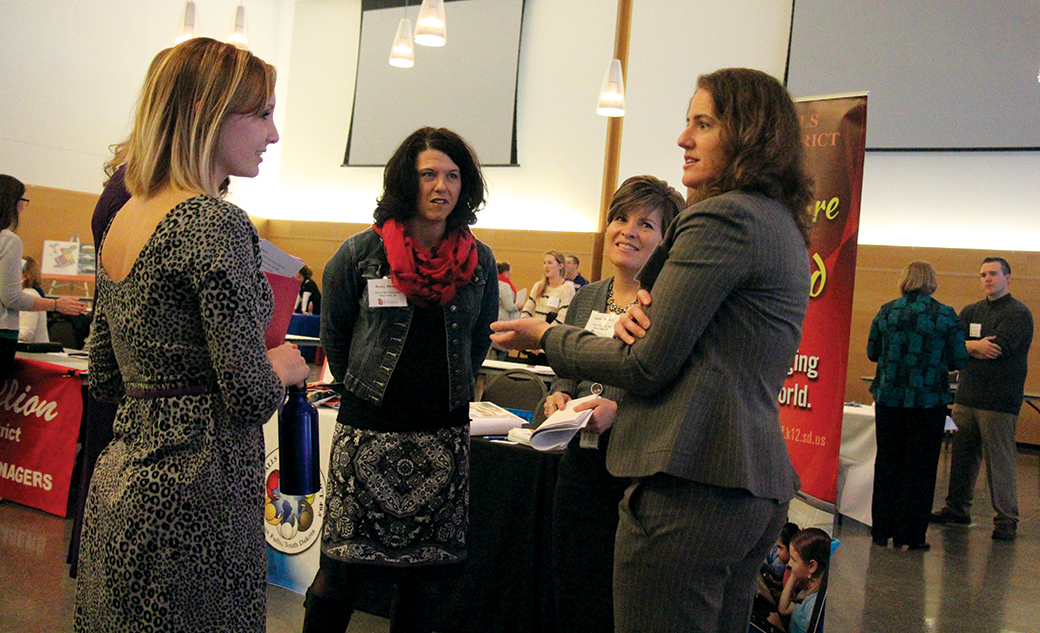
Networking event aims to address state’s teacher shortage
More than 100 juniors and seniors in the Teacher Education program visited the MUC Ballroom this past Friday, with resumes in hand, for USD’s first teacher candidate networking event.
While the first hour was reserved for seniors looking for jobs after graduation, juniors came during the second hour to discuss internships and student teacher positions.
Sherrie Bosse, an academic adviser, was one faculty member that helped organize the event.
The state’s teacher shortage, and districts consequently having difficulty filling positions, were factors behind USD’s interest in hosting the event, Bosse said.
“We felt that it would be beneficial for both them and for candidates to coordinate an event where they could come together,” she said.
Twenty K-12 districts, mostly from South Dakota, were represented, Bosse said.
“USD is preparing more teachers now than we ever have. Our program has grown, but we also see a lot of our graduates maybe return to their home states if they’ve come from out-of-state,” she said. “So we want to make sure that our candidates see the opportunities available to them.”
Robin Wiebers, assistant dean, said the department often gets calls from schools looking for students to fill open positions.
Nick Shudak, division chair, added that events like this one fill gaps and help move districts forward.
“There seems to be a need for this,” he said.
According to the South Dakota Blue Ribbon Task Force’s final report, which addresses the state’s teacher shortage and potential solutions to it, “South Dakota’s salaries lag behind the regional average.”
A few of the task force’s recommendations include:
- Adopt a new formula based on a statewide target for statewide average teacher salary of $48,000 and maintain the average statewide student-to-teacher ratio at approximately 14:1.
- Reevaluate teacher salaries every three years to assure South Dakota remains competitive with surrounding states.
- Full reciprocity be granted to teachers who are certified to teach in another state.
Both Wiebers and Shudak acknowledged that though some districts may not necessarily have certain positions readily available, it’s beneficial for them to put faces to names of applications they may receive in the future.
That’s what junior Anne Coder said she liked about the experience.
“They actually get to see who we are,” she said.
Working toward degrees in special education and elementary education, Coder said she’s interested in teaching third and fourth graders. She’s still uncertain about where she’d like to teach, but said the networking she did at the event was helpful.
“It’s a cool opportunity to walk around and meet people that may be your colleagues,” she said.
Junior Margo Hegge said she was nervous at first, but found the atmosphere to be relaxed and friendly.
There were a few districts with a need for a reading specialist — which is what Hegge hopes to do after she receives her Master’s degree.
“It’s nice to practice interview skills,” she said.
Tanya Rasmussen, curriculum director for the Harrisburg School District, said it’s just as important for schools to be able to sell themselves to candidates.
“It’s great for us to be able to sell our school,” she said. “The teacher pool is getting smaller and smaller.”
That small pool will likely result in districts such as Harrisburg visiting more and more job fairs around the state. Rasmussen said Friday’s event was the first invitation she received from a college campus to come talk to potential teachers.
“I’m glad USD is (doing this),” she said.
Darrell Stacey, an assistant superintendent of the Watertown School District, was also excited to participate in the USD-sponsored event.
“It’s a great event. I think recruiting is a way of the future,” he said. “I think it’s awesome.”
Recruiting juniors for student teacher positions is just as important as recruiting seniors for potential upcoming job openings, Stacey said.
“I’m hoping more campuses do this,” he said.
Rasmussen said she was pleased with the meetings she had with students, many of whom seemed well-prepared.
“It’s good to see the excitement of young educators,” she said.

